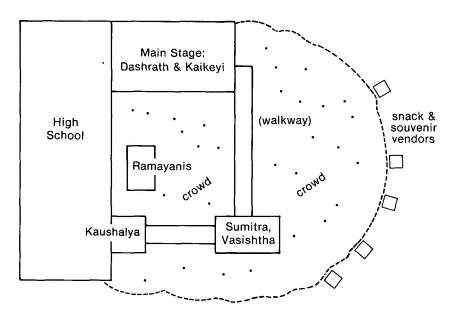Kop Bhavan
Like other Ramlila cycles, the Khojwan production includes both "little" and "big" nights. An example of the former is the episode known as Kop Bhavan (The Sulking Chamber)—the name popularly given to the scene in which Queen Kaikeyi, swayed by her maid Manthara's arguments, demands two boons from King Dashrath, thus precipitating Ram's exile from Ayodhya. At Khojwan this episode is not staged until the fourteenth night—nearly halfway through the cycle. This seemingly delayed beginning Of the central narrative results from the many evenings devoted to introductory stories and an extended treatment of Ram's marriage, which occupies three nights. Such a seemingly disproportionate emphasis on the early portions of the epic is a reflection both of Tulsi's own handling of the story and of the devotional inclinations of later generations of devotees.[70]
Figure 24.
The Kop Bhavan lila at Khojwan
The setting is the royal palace at Ayodhya, which includes the ground-floor stage of the Ramlila Center and the large field fronting it. On this field two small pavilions are erected, connected to the main stage by walkways forming a large rectangle. The pavilions represent various locales within the palace and city; a platform that represents the home of the royal priest Vasishtha later becomes the apartment of Queen Sumitra and the scene of her emotional conversation with Lakshman before his departure for the forest. Another platform in the center of the rectangle is occupied by the Ramayanis, who sit in a circle around a low table bearing two big copies of the Manas . The remaining space within the rectangle is filled by the audience, which also extends into the field beyond (see figure 24).
The crowd is of modest size—perhaps 250 persons—when the performance begins at 9:00 P.M. , but it grows steadily as the night proceeds. Although there are no designated seating areas, men and women instinctively gravitate to opposite sides of the enclosure, as they do at most religious programs. Floodlights mounted on the walls of adjacent buildings provide illumination. No amplification is needed in the semi-en-closed area; on nights when the pageant occurs in more open areas and crowds are larger, a portable loudspeaker is sometimes brought in and its mike passed back and forth between the reciters and the actors. The
crowd is by and large attentive during the performance; people who are less interested gravitate to its fringes, where groups of friends stand gossiping, small children play (some with little bows and arrows, acting out their own Ramlilas ), and snack and souvenir vendors operate throughout the program. But any disturbance within the central area is quickly hushed by the spectators, and most of the children—who probably make up 20 percent of the crowd—sit in rapt attention throughout.
The main stage is outfitted with side curtains and floridly painted backdrops depicting columned halls and vistas of formal gardens complete with topiary and fountains—reflecting the Victorian scenic conventions still prevalent in nautanki[*] stagings of romantic and heroic legends.[71] Dashrath's velvet jacket ornamented with gold braid likewise suggests nineteenth-century courtly dress. The costumes of the boy principals, however, resemble those worn at Ramnagar, which are based on religious iconography and the courtly styles of an earlier period.
The role of Dashrath is played by Kashinath Pathak, the schoolteacher who serves as the director of this lila . He gives a highly histrionic portrayal of the king's reaction to Kaikeyi's demands, collapsing on a gilded couch where he remains, writhing in agony, throughout the evening. His overacting strikes me as comic, but my reaction does not seem to be general; some older spectators are moved to tears. There are other notable performances: the man who portrays Sumitra brings considerable poignancy to the scene in which Lakshman's mother accedes to his request to accompany Ram to the forest. His rendition of her famous speech,
My child, Sita is your mother now,
and Ram, your devoted father.
Ayodhya is wherever Ram resides,
as day is where the sun shines.
2.74.2,3
elicits more handkerchiefs. The boys, who are older than those at Ramnagar, also give competent performances. The local Ram, aged sixteen, is in his second and final year of playing the part—for his upper lip already betrays a faint moustache.
The episode concludes at midnight (quite early for a Khojwan performance, as I would discover) with an arti ceremony modeled after that of
Ramnagar: the boy actors are garlanded and worshiped to the accompaniment of a hymn sung by the Ramayanis and showers of blossoms from behind the scenes. At the same time, a magnesium flare is held aloft, to sear the auspicious tableau on the minds of departing spectators.
